In pursuance to Hon'ble Prime Minister's vision for ‘Transforming India’, Ministry of Human Resource Development took a leap forward in transforming education sector with the motto of “सबको शिक्षा, अच्छी शिक्षा ”(Education for All, Quality Education).
In the year of 2018 MHRD has launched an integrated scheme Samagra Shiksha for School Education to treat school education from pre-school, primary, upper primary, secondary to senior secondary levels as a whole for the betterment of the students. Beside this, MHRD launched so many new schemes in Higher Education Department to boost research & Innovation culture in the country. It is for the first time in the country where any government is emphasizing so much attention on research and innovation. MHRD has given graded autonomy to selected Higher Educational Institutions to promote research and innovation in their campuses so that they can entre in global institutions ranking. Some new important schemes/Initiatives of MHRD like IMPRESS, Study in India, SPARCK, STARS, NTA, NDL, HEFA, LEAP, ARPIT and Innovation Cell etc. are the game changer in the field of education in the country.
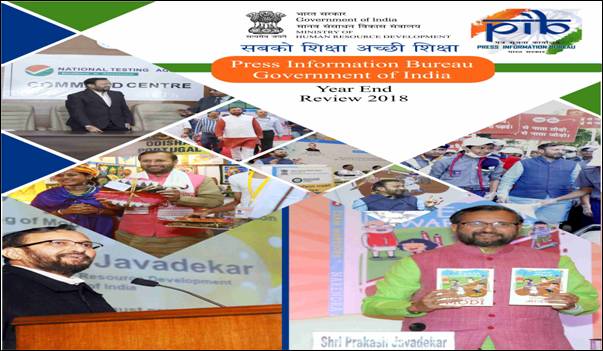

I. Samagra Shiksha - An Integrated Scheme for School Education
|
The Department of School Education & Literacy, Ministry of Human Resource Development has launched an Integrated Scheme for School Education - Samagra Shiksha from 2018-19. Samagra Shiksha envisages ‘school’ as a continuum from pre-school, primary, upper primary, secondary to senior secondary levels.
A total of Rs.30891.81 crore has been provided for Samagra Shiksha in BE 2018-19. Out of Rs.30891.81 crore, an amount of Rs.19808.36 crore (64%) has been released to the States and UTs as Central share (as on 31.12.2018). Preference will be given to educationally backward Blocks (EBBs), Special Focus Districts (SFDs), Border areas and the Aspirational Districts identified by NITI Aayog.
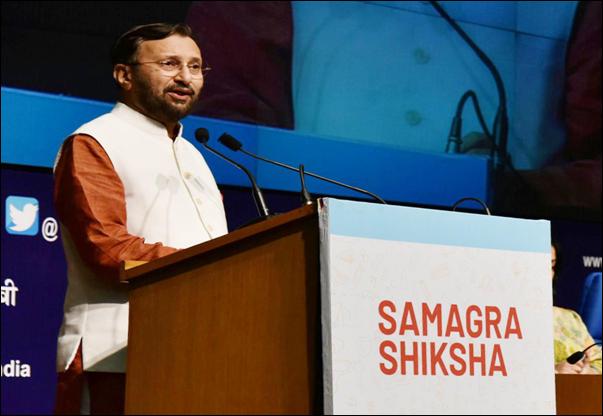
Allocation for uniforms has been enhanced from Rs.400 to 600 per child per annum and allocation for textbooks from Rs.150/250 to Rs.250/400 per child per annum. Energized textbooks have been introduced.
Library Grant under Samagra Shiksha (Padhe Bharat Badhe Bharat)
|
In order to complement the activities under Padhe Bharat Badhe Bharat and inculcate the reading habits among students of all ages, strengthening of school libraries is being undertaken including provision of books by providing library grant for government schools, under the newly launched centrally sponsored scheme of Samagra Shiksha from 2018-19.
For the first time the provision for separate annual library grant has been made covering schools from Primary to Senior Secondary. Reading corners have been created to inculcate habit of reading among children. Library Grant of Rs.5,000 to Rs.20,000 has been provisioned from Primary to Senior Secondary Schools.
In the year 2018-19, an outlay of Rs.47396.14 lakh is estimated under library grant for 702250 schools of different categories.
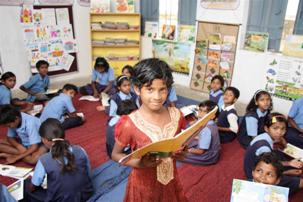
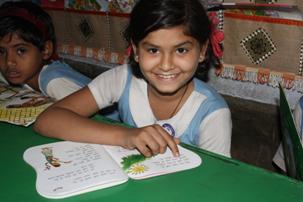
Sports Grant under Samagra Shiksha (Khele India Khile India)
|
Realizing the need for holistic development of children, Samagra Shiksha has included the Sports and Physical Education component to each school under which sports grant is being provided for sports equipments for indoor & outdoor games.
Sports Education has been an integral part of the curriculum. Provision has been made for sports equipment for indoor and outdoor games. Every school will receive sports equipments at the cost of Rs.5000 for Primary Schools, Rs.10,000 for Upper Primary Schools and up to Rs.25,000 for Secondary and Senior Secondary Schools to inculcate and emphasize relevance of sports.
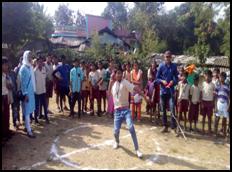
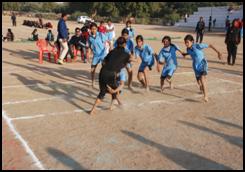 In the year 2018-19, an outlay of Rs.50690.37 lakh has been estimated under sports grant for 894307 schools of different categories.
In the year 2018-19, an outlay of Rs.50690.37 lakh has been estimated under sports grant for 894307 schools of different categories.
Children with Special Needs (CWSN):
|
Stipend of Rs.200 per month for CWSN girls will be provided from Classes I to XII.
Earlier it was only for Classes IX to XII. Allocation for Children with Special Needs (CwSN) has been increased from Rs.3000 to Rs.3500 per child per annum.
In the year 2018-19, an outlay of Rs.102350.91 lakh has been estimated towards CWSN grants.
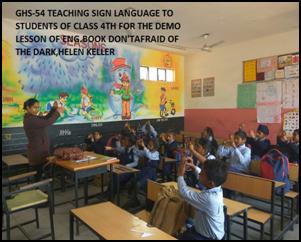
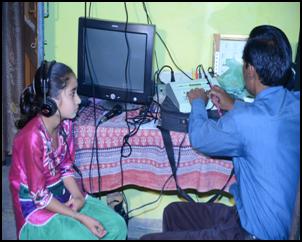
Kasturba Gandhi Balika Vidyalaya (KGBV)
The scheme of Samagra Shiksha has provision for existing KGBVs at upper primary level and Girls Hostels at secondary level to be extended/ converged to provide residential and schooling facilities upto Class-XII. This would provide the facility of at-least one residential school for girls from Classes VI-XII in every educationally backward block which does not have residential schools under any other Scheme.
|
Existing Norms of SSA,
RMSA & TE
|
NEW Norms under the Integrated scheme
|
|
KGBVs and Girls Hostels
- Under SSA, the provision for KGBVs was from Class VI to VIII. Under RMSA, the provision for Girls Hostels was from Class IX to XII.
|
KGBVs to be extended up to Class XII for smooth transition of girls from Elementary to Senior Secondary.
Priority for up-gradation of KGBV where the Girls’ Hostel has been established in the same campus.
|
The girls in the age group 10-18 aspiring to study in Classes VI to XII and belonging to SC, ST, OBC, Minority communities and BPL families form the target group of the scheme. In addition to non-recurring grants for building, the Samagra Shiksha provides for recurring grants as below to account for all expenses including manpower cost:-
- For KGBVs for Classes VI to VIII - upto Rs.60 lakh per annum
- For KGBVs for Classes VI to X - upto Rs.80 lakh per annum
- For KGBVs for Classes VI to XII - upto Rs.1 crore per annum
- For Stand-alone Girls’ Hostels for Classes IX to XII - upto Rs.25 lakh per annum
Since, inception of SSA in 2000-01, 3703 KGBVs has been sanctioned upto 2017-18 with enrolment of 366773 girls. Financial Outlay of Rs.3269.86 crore has been estimated during 2018-19 for meeting expenditure towards KGBVs. 1232 KGBVs have been approved for up-gradation during 2018-19. More than 7.25 lakh rural girls, as per sanctioned capacity, will benefit & mostly from SC, ST, OBC, Minority & other deprived sections of the society
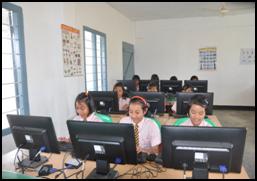
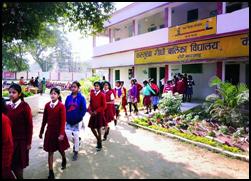
Vocational Education is a scheme under the umbrella of ‘Samagra Shiksha. The scheme seeks to integrate vocational education with general academic education with an aim to prepare educated, employable and competitive human resource for various sectors of the economy and the global market. The scheme covers Government schools and Government aided schools.
The scheme has a provision for providing exposure to vocational education to students of Classes VI to VIII. Till date 9623 schools have been approved under the scheme including 1501 schools approved this year (2018-19). Out of 9623 schools approved, the scheme has so far been implemented in 7470 schools with current reported enrolment of 8,33,041 students.
NSQF compliant vocational courses are taught to the students of class 9th to 12th. At the secondary level i.e. class 9th and 10th, vocational modules are offered to students as an additional subject. At Sr. Secondary level, i.e. class XI and XII, vocational courses are offered as a compulsory (elective) subject. Under the program, there is a provision for
arranging hands - on training for students in industrial set up and guest lectures from industry. The State Governments have been advised that vocational education is to be treated at par with other academic subjects and accorded a similar status.
II. Improving Learning Outcomes and Assessment
|
The Learning Outcomes document for elementary level has been developed in two forms. The complete document includes Curricular Expectations, Pedagogical Processes and Learning Outcomes of classes I to VIII. This document is meant for teachers and teacher educators and school administration to ensure and enhance the quality of learning in schools and the compact version contains only the learning outcomes for each subject in each class. 24 States and UTs (UTs without legislature and Jammu and Kashmir have adopted central rules mutatis mutandis) have incorporated the learning outcomes in their State rules.
NCERT adopted a block named Ichhavar in Sihore district of MP with 190 primary and 100 upper primary schools to provide systematic inputs to enhance students’ learning outcomes. After a base line survey, the inputs in respect of all pedagogical processes including use of kits and other material and Art Integrated Learning are in progress for the last one year.
Further five more blocks in other regions (one each in South, East, North and two in North East) have been adopted by NCERT to implement the NCERT pedagogy and material for enhancement of learning outcomes. It has been planned to have longitudinal studies on the achievement of learning outcomes for both primary and upper primary classes.
NCERT conducted research studies in six blocks of the country to enhance achievement of learning outcomes. The research studies will help i) to assess the age and development appropriateness of learning outcomes identified for each class ii) to assess adequacy of strategies and materials developed by NCERT in achievement of learning outcomes.
These research studies in six blocks of the country have been undertaken to enhance achievement of learning outcomes. The research studies will help i) to assess the age and development appropriateness of learning outcomes identified for each class ii) to assess adequacy of strategies and materials developed by NCERT in achievement of learning outcomes.
It is also planned to prepare interventions in Aspirational Districts in collaboration with the respective SCERTs and district administration to address the issue of Learning Outcomes including other Key Performance Indicators.
Learning Outcomes for secondary stage are being developed by NCERT and will be shared after finalisation.
National Achievement Survey 2017-18
|
NAS assessed the learning levels of the students in Classes 3, 5, 8 and 10, initially the District report cards were released and later the State Learning Reports were made available on the website for Classes 3,5 and 8 in May, 2018 and for Class 10 the State Learning Reports were available in the month of November, 2018. The following two are the links to the State Learning Reports.
http://www.ncert.nic.in/programmes/NAS/SRC.html http://www.ncert.nic.in/programmes/NAS/SRCX.html
The Post NAS Interventions (2018-19) were initiated to reach out to all the Districts in the different States. The learning gaps identified were used to provide feedback to the districts. A framework of intervention to improve the quality of learning in the schools is being suggested. The designing and implementation of the interventions include in its ambit the school leaders, teachers and the whole network of officials at clusters, blocks, DIETs, SCERT and the Directorates of education in the different states/UTs.
Various medium term Post NAS interventions have been initiated, which includes, sharing of findings of NAS with DIETs, BRCCs, and other stakeholders; orientation of BRCCs, CRCCs and teachers on evolving learning strategies to enhance learning outcomes at different grade levels; orientation of school leaders in use of assessment data to improve teaching learning in the States and UTs; facilitating teachers in using alternative instructional strategies to bridge the learning gaps with the support of State functionaries (SCERTs/ SIEs) and seeking support from community to improve the learning levels.
Post NAS interventions have been initiated by NCERT in collaboration with the States of Chhattisgarh, Sikkim, Tripura, Gujarat, Maharashtra, Jammu and Kashmir and Goa.
Operation Digital Board (ODB) would provide Smart Classroom facility to all 101580 schools with secondary and senior secondary classes, over the next five years. All class rooms in these schools will have the facility, thereby enhancing digital penetration and aiding digital learning among students.
School based Assessment (Annual Achievement Survey)
|
In order to objectively assess the learning outcomes, this Department has already initiated the process of conducting the National Achievement Survey (NAS), which is an external evaluation, at regular intervals. The process has been developed after detailed and nuanced interactions with all the stakeholders. The results of the NAS held in 2017-18 are already available in the public domain.
Further, based on the evidence gathered from the survey of 2.2 million students during the NAS conducted in 2017, and the subsequent targeted interventions by NCERT in a pilot survey for creating a framework to improve learning outcomes, it has been decided to conduct a School Based Assessment (SBA) in 2019, which would be a qualitative and non threatening evaluation process of the students by the respective schools.
These quantitative and qualitative evaluation techniques, in tandem with the external evaluation, are crucial to ensure that the desired learning outcomes are reached. Both these evaluations are therefore essential and form a logical continuum.
Participation of India in Programme for International Students Assessment (PISA)
|
The Programme for International Students Assessment (PISA) will be conducted by the Organization for Economic Cooperation and Development (OECD) in 2021. PISA was launched by OECD in 1997, first administered in 2000 and now covers approximately 80 countries. The key features of PISA are as under:
i. PISA is a triennial international survey (every three years) which aims to evaluate the education system worldwide by testing the skills and knowledge of 15-year-old students.
ii. Students were assessed in reading, mathematics, science and collaborative problem-solving.
iii. Within the country (or specific geography to be covered), PISA covers a sample of 15-year-old students representing all forms of schooling i.e. public, private, private aided etc i.e. sample is derived from the entire population of 15-year-old school going children.
iv. PISA, unlike content-based assessment, measures the extent to which students have acquired key competencies that are essential for full participation in modern societies.
v. Participation in PISA allows benchmarking performance against a wide range of countries.
vi. PISA uses test items aligned with international benchmarks. Test items are adapted to the local context and language, pilot tested and validated before being used for the test.
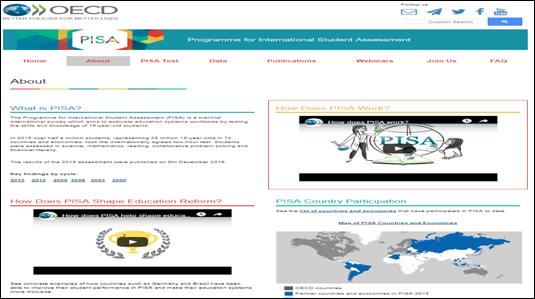
India will participate in PISA 2021 through schools run by Kendriya Vidyalaya Sangathan (KVS), Navodaya Vidyalaya Samiti (NVS) and the UT of Chandigarh. It was decided after due consideration that the computer-based testing mode would not be suitable for Indian students at this point in time and as of now the mode of testing would be paper-based. The preparations for PISA 2021 have been initiated. An International Treaty will be signed between MHRD and OECD for this purpose. The World Bank will be providing technical support as well as financial assistance to the tune of USD 5.6 million for all activities related to PISA.
Review of Syllabus and Textbooks of NCERT
|
The NCERT has undertaken review of Syllabi and Textbooks developed by the NCERT as a follow up of the National Curriculum Framework-2005 in 2017-18. All the textbooks of NCERT developed as a follow-up of the NCF-2005 have been reviewed for updating. A portal for teachers’ suggestions on the NCERT textbooks was created. Suggestions received from teachers were analysed and incorporated if found appropriate in this review. Further, national initiatives such as Clean India, Digital India, Beti Bachao Beti Padhao, Demonetization, etc., have also been given space in the reviewed textbooks in integrated manner. Data was updated in the light of Census 2011. Reviewed textbooks have been implemented for the year 2018-19.
Seven joint committees drawing memberships from the NCERT, CBSE, NVS and KVS were constituted by the NCERT to discuss syllabus and textbooks at the secondary and senior secondary stages and the issues regarding assessment and examination. These committees were constituted as a follow up of the meeting held at the MHRD on 5th June 2017 and 5th July 2017 under the Chairpersonship of Secretary, School Education and Literacy, MHRD, in which two major recommendations were made- 1. CBSE will not publish any textbook henceforth. All the textbooks shall be published by the NCERT only and 2. Joint Committees to be constituted to discuss these issues further.
Joint committees held their meetings from September-November, 2017 and the minutes of the meetings were shared with all the participating organisations for further actions. As a follow-up of the meetings of these joint committees, NCERT has taken initiative to develop workbooks in English and Sanskrit for classes IX and X and also development and updating of syllabi and textbooks for Computer Science (XI-XII), Information and Communication Technology(IX-XII) and Informatics Practices(XI-XII) as well as Biotechnology(XI-XII).
In 2018-19, as per the advice of MHRD, the NCERT has again undertaken review of its textbooks under the initiative of Rationalisation of Curriculum. In this regard, MHRD invited suggestions from different stakeholders. Received suggestions were analysed by the NCERT’s faculty members along with experts from different institutions. Now, NCERT is in the process of finalizing its textbooks for 2019-20 including QR codes in each of the textbook titles.
NCERT to distribute over 6 crore textbooks
|
NCERT launched a portal in August, 2017 to facilitate individuals, schools, States and UTs to directly purchase textbooks. NCERT printed 4.15 crore textbooks by June, 2014 for the session 2014-15, 4.17 crore textbooks by June, 2015 for the session 2015-16, 4.35 crore textbooks by June, 2016 for the session 2016-17, 4.63 crore textbooks by June, 2017 for the session 2017-18, and 5.91 crore textbooks by June, 2018 for the session 2018-19. It is expected that NCERT will be able to print 6.03 crore textbooks by June, 2019 for the session 2019-20. Textbooks will be distributed through four Regional Production-cum-Distribution Centres already established at Ahmedabad, Bengaluru, Guwahati and Kolkata apart from Delhi. NCERT has also empanelled 895 vendors across the country for distribution of textbooks.
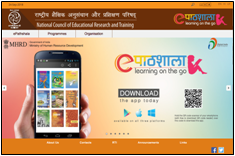
e-Pathshala
NCERT books are available free in digital version. 15 lakh students have downloaded the e-pathshala app. Visits in one year has crossed 30 million mark.
III. Credible Data and Accountability
|
The Unified District Information on School Education (UDISE) collects data on all schools in the country. From 2018-19, it has been decided to update the UDISE and introduce new features. The UDISE+ (i.e., UDISE Plus) application will be online and will gradually move towards collecting real-time data. UDISE+ application, in addition to data collection, will have the following features:
a) A Dashboard with data analytics and data visualization will be developed. It will include time series data to study the trend over years and monitor growth. Progress in Key Performance indicators will be tracked.
b) The system will be linked to GIS mapping and School Report Cards will be generated.
c) To ensure data quality, a separate module for third party verification will be developed including a mobile app.
The process of data collection will start in January, 2019.
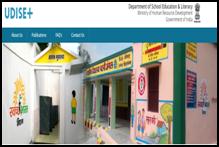
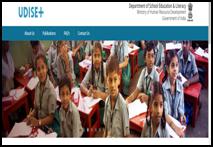
Performance Grading Index (PGI)
|
The PGI is for the purpose of grading States and UTs on their performance across 70 indicators on school education.
i. The Index will grade States and UTS thus allowing for more than one State/UT to occupy the same grade, and therefore all 36 States and UTS to ultimately reach the highest level. The PGI has been conceptualised as a tool to encourage States and UTS to adopt certain practices like online recruitment and transfer of Teachers, electronic attendance of Students & Teachers etc.
ii. The PGI has seventy (70) indicators divided into two categories viz Outcomes and Governance processes. The first category is divided into four domains viz. Learning outcomes, Access outcomes, Infrastructure and Facilities and Equity outcomes; the second category is about Governance processes which covers attendance, teacher adequacy, administrative adequacy, training, accountability and transparency.
The total weightage under PGI is thousand points. Each indicator has been given either twenty or ten points.
The data for the year 2017-18 has been received and compiled for all the State/UTs and final grading has been done after third party verification of data by UNICEF. The Index will be officially released shortly.
On 18th January 2017, the Hon’ble Minister for Human Resource Development launched the Shagun portal – www.seshagun.nic.in. It has two modules – (1) Repository of innovation and (2) Online monitoring.
Repository: This repository of good practices focuses on positive stories and developments that are driving performance improvements in school education. These innovative practices are documented in the form of case studies, videos, testimonials and images.
This digital platform is for public, media, stakeholders, influencers and global academia to witness the innovative ideas and success stories being registered in the field of elementary education. Innovations that have benefited State Governments, public schools, teachers and students are documented and disseminated through this repository. In the Shagun Repository, there are 277 videos on best practices, 266 case studies, 151 testimonials and 4537 photographs.
In the year 2018-19, the department decided to expand the repository by covering all the schemes of the department and activities of various autonomous bodies such as NCERT, NIEPA, CBSE, NCTE, NIOS, KVS, NVS and National Bal Bhawan (NBB).
Monitoring: The online monitoring module of Shagun measures state-level performance and progress against key educational indicators which enables DSEL and education departments of State and UTs to conduct real-time assessments.
The main functions are fund utilisation tracking, performance measurement on key educational indicators, online planning & goal setting, physical targets and outcomes monitoring.
The portal offers data analytics and generates graphics which represent the progress of States and UTs against key identified parameters such as exact number of out of school children mainstreamed, the increase or decrease in enrolment in government schools vis-à-vis private schools, expenditure on increasing the learning outcomes, and teachers’ salaries.
In a major initiative, all Government schools throughout the country will be visited and checked during August-September, 2019. The Shagunotsav will focus primarily on infrastructure and facilities in all schools and this will be mapped online. The feedback will be used to verify the UDISE + data-base and certain indicators under the Performance Grading Index.
IV. Recognising Good Performance
|
National Awards to Teachers
|
These Awards were instituted in 1958. From the mid-1960s, 5th September came to be the fixed date for the function on account of birthday of Dr. Sarvapalli Radhakrishnan, former President of India. Over the years, the number of awards increased to 378 awards, but it was felt that the Awards were losing their stature.
The guidelines of the scheme were revised in the year 2018 along the pattern of the changes made in major national awards. The new scheme is transparent, fair, and rewards demonstrated excellence and performance.
The features of the new scheme are as under:
- Online self-nominations from teachers were invited on www.mhrd.gov.in. The Web portal was developed by the Administrative Staff College of India (ASCI) and the entire software ran smoothly without any glitches or complaints.
- About 6000 applications were received from teachers from all over the country clearly indicating that the initiative was successful.
- All regular teachers were eligible and no minimum years of service was required. This enabled meritorious young teachers to apply.
- The number of awards was rationalized to 45, thereby restoring the prestige of the awards.
- No State, UT or Organization had a quota in the final selection. This encouraged them to compete for the awards.
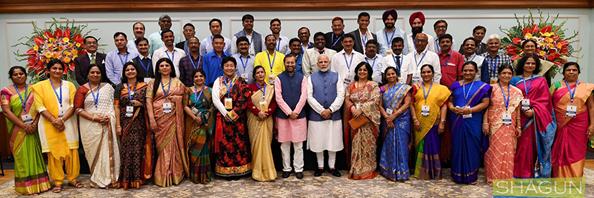 An independent Jury at the National level made the final selection. The Jury reviewed the list of 152 candidates forwarded by all States, UTs and Organisations. Each nominee made a presentation before the Jury, which made a final assessment and recommended 45 names for the Teachers Awards.
An independent Jury at the National level made the final selection. The Jury reviewed the list of 152 candidates forwarded by all States, UTs and Organisations. Each nominee made a presentation before the Jury, which made a final assessment and recommended 45 names for the Teachers Awards.
Hon’ble Prime Minister interacted with and felicitated the awardee teachers at his residence on 4th September 2018. The Hon’ble Prime Minister also tweeted about his interaction with the awardees.
While Awardees like Mr. Arvind Jajware from Jharkhand and Mr. Vikram Adsul from Maharashtra practiced joyful learning to reduce drop outs and increase enrolment, teachers like Mr. Rakesh Patel from Gujarat, Mr. Imran Khan from Rajasthan deployed ICT and child friendly activity based learning to transform their Schools into abodes of learning. Teachers like Ms. Shaila R.N. from Karnataka mobilized community support to improve school infrastructure for the benefit of students while Ms. Karma Chomu Bhutia from Sikkim strived hard for increasing enrolment.
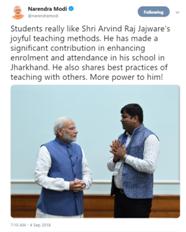
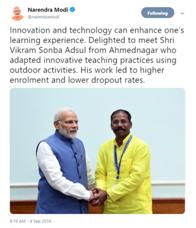
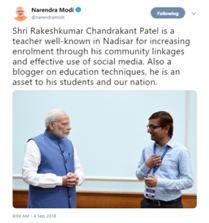
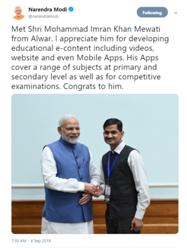
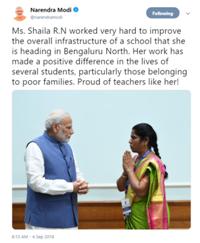
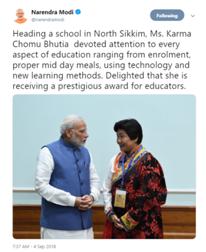
Hon’ble Vice President of India gave away the Awards at Vigyan Bhawan on 5th September 2018. Films on the achievements of each awardee were also shown during the ceremony.
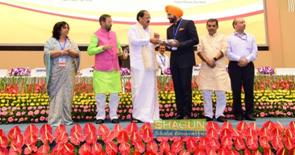

Awarding cleanest schools under Swachh Vidyalaya Puraskar
|
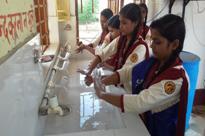
The Department of School Education & Literacy instituted Swachh Vidyalaya Puraskar (SVP) in 2016-17 at District, State and National level as a next step to Swachh Vidyalaya Initiative. These awards are given to ensure long term sustainability and behaviour change towards cleanliness in schools. Swachh Vidyalaya Puraskar is an initiative to recognize, inspire and celebrate excellence in water, sanitation and hygiene practices in schools. The schools voluntarily applied online through a website and mobile App for the awards.Swachh Vidyalaya Puraskar 2017-18 was open to Private schools besides Government and Government aided schools.
Methodology for the awards
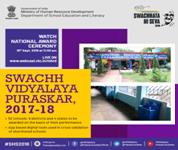
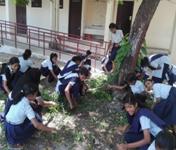
Selection of schools for the awards is made on the basis of scores obtained by them in five sub-categories, namely (i) Water, (ii) Toilet, (iii) Hand washing with Soap, (iv) Operations and Maintenance, (v) Behaviour Change and Capacity Building. The best schools selected for the National award are given a cash prize of Rs. 50,000/- as an additional school grant for sustaining and improving sanitation and hygiene conditions in the school, alongwith a Certificate of Recognition. The best States and top Districts which participated in the Swachh Vidyalaya Puraskar are also recognised.
Swachh Vidyalaya Praskhar 2017-18
SVP 2017-18 received overwhelming response from schools. 6,15,152 schools registered online for the Swachh Vidyalaya Puraskar 2017-18, which is more than double the number of schools which participated in the previous year. States and UTs shortlisted 727 schools for consideration of the National level awards.
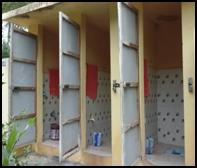
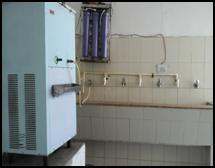
After cross validation and thorough screening top 52 schools were conferred the National Awards for SVP 2017-18. The top 4 States viz. Puducherry, Tamil Nadu, Gujarat and Andhra Pradesh and the best 9 districts viz. Pondicherry, Srikakulam, Chandigarh, Hisar, Karaikal, Latur, Nellore, South Goa and Vadodara, were given the certificates of recognition during the function held on 18.9.2018.
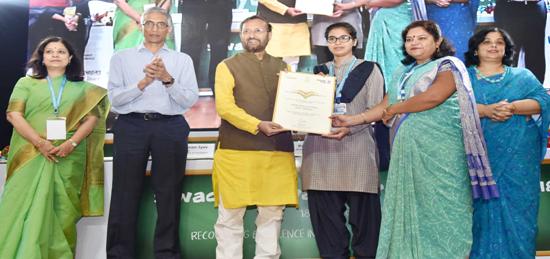
V. Schools run by the Department
|
New KV Schools and Buildings:
|
New KVs sanctioned during the year 2018-19:
13 Kendriya Vidyalayas were sanctioned by CCEA on 01.08.2018, in the districts of Baghpat (UP), Chandel (Manipur), Washim (Maharashtra), Chikkaballapur (Karnataka), Greater Noida (Utttar Pradesh), Siddipet (Telangana), Parbhani (Maharashtra), Aurangabad (LWE) (Bihar), Nawada (LWE) (Bihar), Palamu (LWE) (Jharkhand), Banda (Uttar Pradesh), Bhadohi (Uttar Pradesh) and Mirjajpur (Uttar Pradesh)
Details of new KVs opened:
During 2018-19, 16 New KVs have been opened throughout India namely, in the districts of Koppal (Karnataka), Pathanamthitta (Kerala), Seoni (Madhya Pradesh), Jodhpur (Rajasthan), Pali (Rajasthan), Nizamabad(Telangana), Aurangabad (Bihar), Mysuru (Karnataka), Baghpat (Uttar Pradesh), Chandel (Manipur), Washim (Maharashtra), Chikkaballapur (Karnataka), Siddipet (Telangana), Parbhani (Maharashtra); Harisingh Gaur University (Madhya Pradesh) and SSG, CISF Camp, Greater Noida (Uttar Pradesh).
Details of school buildings completed during 2018-19: Following new school buildings were completed; three buildings in Assam (Tamulpur, Golaghat & Haflong), two in Bihar (Sasaram & Araria), two in Chhattisgarh (Rajnandgaon & Janjgir), one in Narela (Delhi), two in Gujarat (Jetpur &Viramgaon), one in Kathua (J & K), one in Godda district (Jharkhand), one in Karwar (Karnataka), four in Madhya Pradesh (Tikamgarh, No.2 Rewa, Sheopur & Datia), two in Uttar Pradesh (Hardoi & Shivgarh, one in Rajgarhi (Uttarakhand) & one in BSF Gandhinagar (West Bengal)
Details of school buildings Inaugurated during 2018-19:
During 2018-19, 14 new KV School Buildings have been inaugurated throughout India, namely., Sasaram (Bihar), Kathua (J & K), No.2 Rewa & Tikamgarh (MP), Rajnandgaon (Chhattisgarh), Godda (Jharkhand), Jajpur & Kendrapada (Odisha), Mangaldoi (Assam), Virudhunagar (Tamil Nadu), Chamarajanagara (Karnataka), SAS Nagar Mohali (Punjab), Inderpura (Rajasthan) & Madhupur (Jharkhand)
Foundation Stone Laid:
During 2018-19 foundation stone was laid for 4 KVSs in UP namely Deoria, Baoli Baghpat, Lakhimpur Khiri, Srawasti.
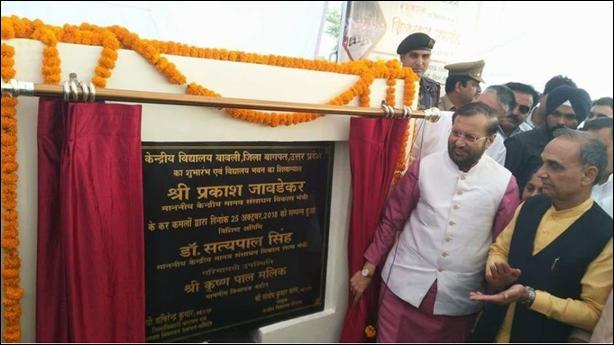
One JNV was sanctioned during 2018-19 namely ‘Ratlam-ii’. Six new NVs were made functional in 2018-19 namely Ratlam-ii, Fazilka, Ramban, Sabarkantha, East Jaintia Hills and Kistwar. One new building was sanctioned during 2018-19 for ‘Ratlam-ii’ and three new buildings were started in 2018-19 for Jhabua-ii, Malkangiri-ii and Rampur. Foundation Stone was laid for Ratlam-ii in 2018-19.
VI. Promoting Joyful Learning
|
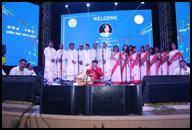
Cultural activities including art, music, dance and theatre play a very critical role in a student’s life and school activities. The National Curriculum Framework emphasized the importance of such activities and how they helped to enhance learning.
A fortnight of cultural activities for both students and teachers was conducted concluding on 21st December, 2018. Titled Rangotsav, it comprised activities at the school level, culminating in national level events including the following -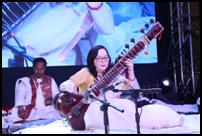
(a) National Role Play Competition (at NCERT)
(b) National Folk Dance Competition (at NCERT)
(c) Kala Utsav (including solo singing, dancing, and musical instruments) (at Sirifort Auditorium)
(d) National Competition of Art and Music Teachers of Kendriya Vidyalayas and Navodaya Vidyalayas (at Ambedkar Bhawan)
(e) National Level Inter School Band Competition for Boys and Girls (at Thyagraj Stadium)
(f) Bhasha Sangam (from 20th November to 21st December, 2018) (in all schools)
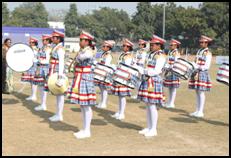
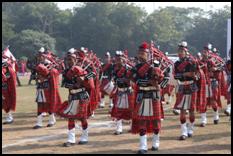
Kala Utsav
Kala Utsav is an initiative of DSE&L, MHRD to promote arts in education by nurturing and showcasing the artistic talent of school students of government and government aided schools at the secondary stage (Class IX-XII) of education in the country. The event was organised at New Delhi from 12-14 December 2018. ‘Kala Utsav’ focuses on both performing and visual arts & crafts (dance, music, theatre, painting, sculpture and heritage crafts) at school, district and State level, to enhance awareness of India’s cultural heritage and its vibrant diversity amongst students, teachers, teacher educators, administrators and other stakeholders and aims to promote networking of artists and artisans with school education.
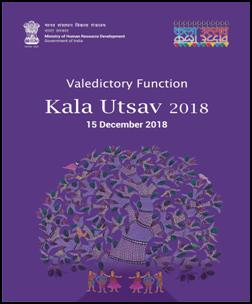
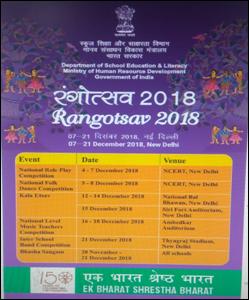
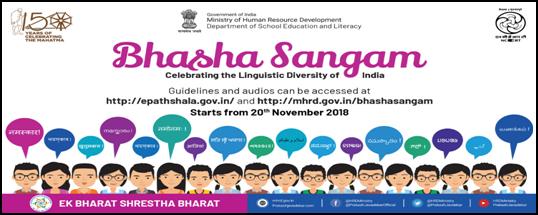
Ek Bharat Shresth Bharat - National Level Camp
|
Kendriya Vidyalaya Sangathan organized Rashtriya Ekta Shivir- Ek Bharat Shrestha Bharat form 31st October – 2nd November, 2018 in New Delhi.
A total number of 1600 students and 175 escort teachers of Kendriya Vidyalayas from all the 25 Regions participated in the National Level camp. Following competitions were conducted during KVS “Ek Bharat Shresth Bharat-2018”:
- Group song, group dance (state & international), theatre, on spot painting, solo singing, solo classical dance and display of artefacts
- Debates (Hindi & English), quiz, Sanskrit shloka recitation, Hindi kavya paath, English elocution, creative writing, spell-bee
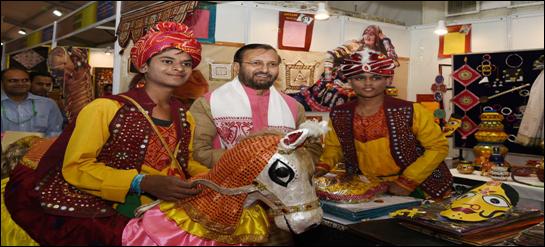
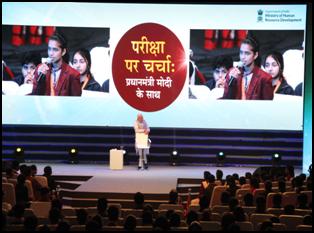
Prime Minister’s Interaction Programme with school and college students "Pariksha Pe Charcha" was held at Talkatora Stadium, New Delhi on 16th February, 2018.
This program was a ‘Town Hall’ event which was unique in itself and was planned for the first time wherein Hon’ble Prime Minister was interacting Live with school and college students in the Stadium and through Web Interaction across the Country. Written questions were invited from the students across the country for the interaction programme on MyGov platform. About 18,000 written questions were received out of which 40 questions were first shortlisted. Thereafter, Doordarshan was requested to video shoot these shortlisted questions and a few students from IIT Mumbai, BHU, etc prepared their own video of the question and sent it to MHRD. The final questions were then decided keeping in view the topic for the interaction.
Students from all over the country from class VI to XII and those in higher educational institutions were requested to see/hear the broadcast on Doordarshan (DD National, DD News, DD India)/on radio channels (All India Radio Medium Wave, All India Radio FM Channel). 2500 students from various schools and colleges along with teachers and principals were invited to attend the live interaction at Talkatora Stadium. Accordingly, instructions and advisories were issued to all government and aided schools and government run higher education institutions to make necessary arrangements so that students can view the program. Necessary advisories were also issued to private schools and institutions.
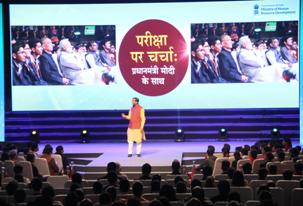
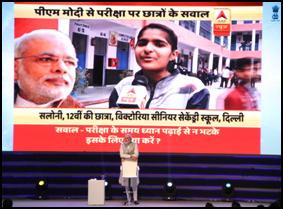
The Pariksha Pe Charcha Programme was planned as a one hour interaction of Hon'ble PM, continued for nearly two hours. There were more than 2500 students from schools and colleges who were present in Talkatora Stadium of 16th February, 2018 for the interaction and more than 8.5 Crore students from across the country viewed or heard the programme on DD/TV Channels/ Radio Channels.
The programme was widely covered by print and electronic media. As per media reports, the interaction programme, became a raging hit on social media, and was the No. 1 trend conversation, which got more than 2.5 billion impression on twitter. It was widely viewed on Youtube, Facebook Live, through webcasting, etc.
Central Board of Secondary Education (CBSE) is an examination conducting body under administrative control of the Ministry of Human Resource Development and affiliates schools for conduct of the Class X and XII Examination. The Board has 10 Regional Offices and more than 21000 affiliated schools.
Affiliation
The Board has developed and implemented online software for affiliation process from 2018-19 session. Now, the application for affiliation from the submission to the final grant has been integrated with electronic communication and is completely transparent. The stakeholder can now keep track of his application at every stage.
The Affiliation bye-laws have been completely revamped to ensure speed, transparency, hassle-free procedures and ease of doing business with CBSE. The Hon’ble Minister for HRD released the new CBSE Affiliation bye-laws at a press conference highlighting the main changes.
Examination Reforms
- Exemption/concessions being extended to Persons with Benchmark Disabilities as per the Persons with Disabilities Act, 2016 have been complied and also the schedule for making requests to avail facilities/exemptions circulated vide Circular dated 26.09.2018 and 05.11.2018. The Board has notified the policy for facilitation of Children with Special Needs (CWSN).
- Revised guidelines have been formulated for fixing schools as examination centres. More choices have been provided in question papers.
- OASIS has been introduced as a single window solution for many examinations related activities.
- The Board has successfully implemented the pilot project for delivering of encrypted question papers in the Compartment 2018 examinations for Class X & XII.
National Curriculum Framework
Board has recently issued a circular No. Acad 25/2018 dated 13.08.2018 to all affiliated schools, on adherence to the provision of National Curriculum Framework (NCF), 2005 with regard to curriculum load, no homework to students upto Class II as prescribed by NCERT and reduction in the weight of school bags.

New Initiatives of Department of Higher Education
National Testing Agency
§ National Testing Agency (NTA) has been established as an autonomous and self-sustained premier testing organization to conduct all entrance examinations for higher education institutions in the country.
§ NTA has already successfully conducted its first online exam for SWAYAM in December first week for about 3800 learners.
§ UGC/ NET examination has also been successfully conducted by NTA on 18.12.2018. About 9.5 lakhs post graduate level students took this examination. The JEE examination in January 2019 will also be conducted by NTA for about 9.5 lakh students.
§ Improving Gender Balance:
With a view to improving female enrolment in the B.Tech Programmes in IITs, a Committee under the chairmanship of Director, IIT-Mandi was constituted by the Joint Admission Board (JAB) to suggest suitable measures. The recommendations of the Committee were considered by the IIT Council in its 51st meeting held on 28.04.2017 and decided to increase female enrolment from the current 8% to 14% in 2018-19, 17% in 2019-20 and 20% in 2020-21 by creating supernumerary seats.
§ Prime Minister Research Fellows:-
With a view to tap the talent pool of the country for carrying out research in digeneously in cutting edge science and technology, MHRD has launched a Scheme called ‘Prime Minister’s Research Fellows (PMRF) for a period of seven years beginning 2018-19 with the approval of Cabinet. 135 students have been selected for PMRf DURING THE YEAR 2018.
With effect from 2019, B.Tech./M.Tech students from any recognised Indian institution will be offered direct admission in PhD programme in the IITs/IISc. Such students, who fulfill the eligibility criteria, and shortlisted through a selection process, as laid down in the PMRF Guidelines, will be offered a fellowship of Rs.70,000/- per month for the first two years, Rs.75,000/- per month for the 3rd year, and Rs.80,000/- per month in the 4th and 5th years.
Apart from this, a research grant of Rs.2.00 lakh will be provided to each of the Fellows for a period of 5 years to cover their foreign travel expenses for presenting research papers in international conferences and seminars. A maximum of 3000 Fellows would be selected in a three year period.
§ Higher Education Financing Agency (HEFA):
-
- This is implemented under the initiative of “Revitalising Infrastructure & Systems in Education (RISE) by 2022
- HEFA will provide Rs 1,00,000 crore in next 4 years
- Till now about Rs.12700 crore of loan has already been sanctioned.
- HEFA is also being used by Ministry of Health for funding of construction of four AIIMS. Loanhave already been sanctioned to AIIMS Gorakhpur and AIIMS Bhatinda (Punjab).
§ Scheme for Promotion of Research Collaboration (SPARC) –
In order to facilitate research and academic collaboration with top academic institutions in the world, it has been decided that Government will fund such collaboration between Indian institutions which are in top 100 of either subject specific NIRF ranking or aggregate NIRF ranking on one hand and with foreign institutions figuring in top 500 QS world ranking.
About 800 proposals have already been received (last date 7.12.2018). Some of the foreign educational institutions who have already applied for joint collaboration are MIT, Harvard, London School of Economics, National Technological University Singapore, National University of Singapore, University of Cambridge etc.
- STARS (Scheme for Transformational and Advanced Research in Sciences) –
This scheme has been initiated for accelerating inter-disciplinary and transformative research in the field of science by allowing educational institutions in the hinterland to collaborate with established research centres in science.
Coordinated by IISc Bangalore, STARS aims at making available high end research funding in the field of science to researchers in small edcuational institutions. Rs.487 crore is earmarked for this.
§ Innovation Cell and Atal Ranking of Institutions on Innovation Achievements (ARIIA) –
Innovation cell is MHRD’s initiative and has been established at AICTE premises with a purpose to systematically foster the culture of Innovation in all Higher Education Institutions (HEIs) across the country.
For the real outcome there has to be some assessment of what is being done to promote innovation. Therefore, Atal Ranking of Institutions on Innovation Achievements (ARIIA) has also been launched. It will encourage healthy competiveness among Higher Educational Institutions.
§ Swachh Bharat Summer Internship
- The Ministry of Drinking Water and Sanitation, in association with the Ministry of Human Resource Development, has come up with the innovative ‘Swachh Bharat Summer Internship (SBSI) 2018’aimed at engaging the college youth with Swachhata work in villages in the Summer vacation.
- 2 lakh students enrolled
- Students spend 100 hours in a village where he or she will work with people of the village to make it clean
§ Revamp in technical education –
To develop analytical understanding and to acquire a holistic perception of the subjects being taught, the technical examination system has been revamped with less emphasis on rote learning. Internship has been made mandatory for Diploma and Degree engineering students so that they have exposure to industry practise for the pass out.
§ Unnat Bharat Abhiyan & Unnat Bharat Abhiyan 2.0
- Every institution adopts 5 villages
- Use of knowledge for social, economic growth
- Technical institutions design technical solutions for local issues
- Unnat Bharat Abhiyan (UBA) 2.0-a flagship program of MHRD, 688 institutions are selected on a Challenge Mode (426 technical and 262 non- technical) which are reputed Higher Educational Institutes (both public and private) of the country, which have adopted total no. of 3555 villages for their development through UBA
Smart India Hackathon
§ A unique IT Initiative under which students are encouraged to apply knowledge to the real life situations and to find innovative solutions to the day to day problems
§ Smart India Hackathon 2018 (SIH 2018) was launched on 16th October 2017. It includes 2 sub-editions – Software as well as Hardware:
- Software Edition- 36-hour software product development competition, similar in concept to SIH 2017.
- In the new Hardware Edition of the Hackathon, the teams work for 5 consecutive days and build their hardware solutions for the proposed problem statements.
- The Grand Finale of Software Edition SIH 2018 was held on 30th & 31st March, 2018.
- The SIH 2019 is going to invite real life problems from industry as well. Advertisement for applications for SIH 2019 has already been placed in newspaper on 04.12.2018.
- SIH 2019 aims at developing software and hardware solutions to industrial problems. To sustain these initiatives, good and innovative solutions will be handed over to the incubation cell of the institute where angel investors can financially support commercially viable innovations.
National Institutional Ranking Framework (NIRF)
§ 3rd successful year of competing excellence & ranking
§ Has become a benchmark of quality and creates competitive spirit among the institutes
§ Shri Prakash Javadekar, released the NIRF India Rankings 2018 in various categories on the basis of performance of Higher Educational Institutions in April 2018.
§ A total of 2809 institutions have participated in 9 categories. Collectively they have submitted 3954 distinct profiles, some in multiple disciplines/categories. This includes 301 Universities, 906 Engineering Institutions, 487 Management Institutions, 286 Pharmacy Institutions, 71 Law Institutions, 101 Medical Institutions, 59 Architecture Institutions and 1087 General Degree Colleges.69 top institutions in 9 categories were given awards.This year also saw the beginning of limited ranking of institutions in new areas like Medicine, Law and Architecture.
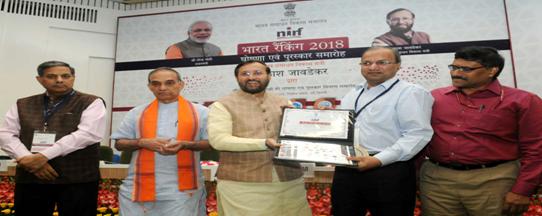
- Government of India launched the Study in India program on 18th April, 2018 in New Delhi.
- Students from 30 countries across South Asia, Africa, CIS and Middle East can apply for different courses from 160 select Indian institutions (both public & private) which are high on NAAC and NIRF ranking
- It will improve the global ranking of Indian Institutions
- Study in India program has taken off well and nearly 2000 students have got admission in selected 100 top Indian Institutions for the first season.
|
RESEARCH &QUALITY HIGHER EDUCATION
|
AICTE has released a sum of Rs. 11.77 Crore under Research Promotional Scheme in the current Financial Year. The scheme aims at promoting research in engineering sciences and innovations in established and newer technologies; and to generate Master’s and Doctoral degree candidates to augment the quality of faculty and research. Under Modernisation and Removal of Obsolescence (MODROBS), AICTE has granted a sum of Rs. 16 Crore in the present financial year to the institutes for removing obsolescence in laboratories, workshops, etc.
- 5 New Research Parks at IIT Delhi, IIT Guwahati, IIT Kanpur, IIT Hyderabad and IISc Bangalore @ Rs.75 crore each approved.
National Digital Library (NDL)
With the Government’s commitment towards “Padhe Bharat Badhe Bharat” the Union Human Resource Development Minister, Shri Prakash Javadekar launched the new digital initiative of HRD Ministry ‘National Digital Library of India’ on the occasion of National Reading Day i.e. 19th June, 2018.
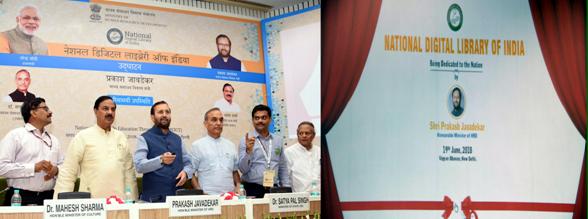
This National Digital Library of India (NDLI) is a project of the Ministry of Human Resource Development under the aegis of National Mission on Education through Information and Communication Technology (NMEICT
- 1.9 Crore e-books and documents are available.
- Content is available in English, Hindi and about 200 other languages.
- There are 160 Content contributor.
- There are 30 lakh users
- 9 thousand educational institutions from where users registered
|
Impactful Policy Research in Social Sciences (IMPRESS)
|
The Union Minister for Human Resource Development Shri Prakash Javadekar launched the web portal of the Scheme “Impactful Policy Research in Social Sciences (IMPRESS)” in New Delhi on 25th October, 2018.
Under the Scheme, 1500 research projects will be awarded for 2 years to support the social science research in the higher educational institutions and to enable research to guide policy making.
In August 2018, Government sanctioned the scheme “Impactful Policy Research in Social Sciences (IMPRESS)” at a total cost of Rs.414 Cr for implementation up to 31.3.2021 and Indian Council of Social Science and Research (ICSSR) will be the project implementing agency.
The broad objectives of the scheme are:
- To identify and fund research proposals in social sciences with maximum impact on the governance and society.
- To focus research on (11) broad thematic areas such as : State and Democracy, Urban transformation, Media, Culture and Society, Employment, Skills and Rural transformation, Governance, Innovation and Public Policy, Growth, Macro-trade and Economic Policy, Agriculture and Rural Development, Health and Environment, Science and Education, Social Media and Technology, Politics, Law and Economics. The Sub-Theme areas will be decided on the basis of Expert Groups’ advice before notifying the scheme and calling for applications.
- To ensure selection of projects through a transparent, competitive process on online mode.
- To provide opportunity for social science researchers in any institution in the country, including all Universities (Central and State), private institutions with 12(B) status conferred by UGC.
- ICSSR funded/recognised research institutes will also be eligible to submit research proposals on the given themes and sub-themes.
NEW IIMs:
- In the Budget speech 2014-15, six new IIMs were announced. Accordingly, during the year 2015-16, six more IIMs have been established at Amritsar (Punjab), Bodh Gaya (Bihar), Nagpur (Maharashtra), Sambalpur (Odisha), Sirmaur (Himachal Pradesh) and Vishakhapatnam (Andhra Pradesh) and commenced their academic session from 2015-16 from temporary campuses. The Ministry of HRD is providing funds to establish the IIMs for academic activities and setting up of temporary campuses and construction of permanent campuses. A total of Rs.79 crore per institute has been approved for their establishment and operation from the temporary campus during initial years.
- The Union Finance Minister, in his Budget Speech (2015) had inter alia announced setting up of an Indian Institute of Management (IIM) in the State of Jammu & Kashmir. Mentored by IIM Lucknow, IIM Jammu, has started its first academic session in 2016-17 with 54 students from Temporary / transit campus located at old Government College of Engineering & Technology (GCE&T), Canal Road, Jammu. An amount of Rs.61.9 crore per institute has been approved for its establishment and operation from the temporary campus during initial years.
- For the new IIMs which started after 2014 (Jammu, Sirmur, Amritsar, Bodhgaya, Sambalpur, Nagpur, Vishakhapatnam), cabinet approval has been taken for construction of permanent campus at a total outlay of Rs. 3000 cr (approx).
- As the IIM Act has now been passed by the parliament, all IIM boards are now being reconstituted as per the provisions of the Act. This will provide a fillip to the autonomy of IIMs.
Central University
One new Central University has been set up in Motihari, Bihar, and has started functioning from February 2016. Central University of Andhra Pradesh and Central Tribal University of Andhra Pradesh are going to start. The Bill for them is being placed before the Parliament in the current winter session.
In order to ensure simultaneous and coordinated creation of campus for newly established Central Universities, Rs.3600 crore is proposed to be spent on their infrastructural development.
School of Planning and Architecture
Three School of Planning and Architecture made instiuttion of national importance by the passing of SPA Bill 2015
SWAYAM (Study Webs of Active Learning for Young Aspiring Minds)
The Ministry of HRD has embarked on a major and new initiative called 'Study Webs of Active Learning for Young Aspiring Minds' (SWAYAM), which will provide one integrated platform and portal for online courses, using information and communication technology (ICT) and covering all higher education subjects and skill sector courses.
Till date, more than 72 Lakhs learners have been enrolled in more than 16000+ MOOCs courses that have been run through SWAYAM.2 lakh persons have completed the courses.
MOOCs is also now being used to train teachers through Annual Refresher Programme in Teaching (ARPIT). 42000 teachers have already registered for their annual refresher course.
NIOS is one of the National Coordinator of SWAYAM. NIOS is offering 14 secondary level courses and all courses of Diploma in Elementary Education (D.El.Ed).
Scholarships
As per the record maintained by AICTE, a sum of Rs. 292.50 Crore (approx.) has been released to 11,862 GATE qualified M. Tech. students. In addition, Rs. 2.61 Lakh have been released under National Doctoral Fellowship Scheme. Overall, a sum of Rs. 1076 Crore have been released to GATE qualified M. Tech. Students in the last three year
|
Leadership for Academicians Program (LEAP) and Annual Refresher Programme In Teaching (ARPIT) for higher education faculty
|
Ministry of Human Resource Development, launched two new initiatives; Leadership for Academicians Programme (LEAP) and Annual Refresher Programme In Teaching (ARPIT) on 13.11.2018 for Higher Education Faculty
Leadership for Academicians Programme (LEAP) is a three weeks Flagship leadership development training programme (2 weeks domestic and one week foreign training) for second level academic functionaries in public funded higher education institutions. The main objective is to prepare second tier academic heads who are potentially likely to assume leadership roles in the future.
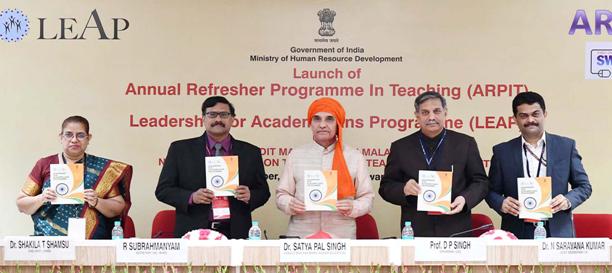
Annual Refresher Programme in Teaching (ARPIT), a major and unique initiative of online professional development of 15 lakh higher education faculty using the MOOCs platform SWAYAM. For implementing ARPIT, 75 discipline-specific institutions have been identified and notified as National Resource Centres (NRCs) in the first phase, which are tasked to prepare online training material with focus on latest developments in the discipline, new & emerging trends, pedagogical improvements and methodologies for transacting revised curriculum.
INDIA SURVEY ON HIGHER EDUCATION
All India Survey on Higher Education (AISHE) was initiated in 2011 in which data for the year 2010-11 were collected. The survey was utmost necessary as none of the sources of data on Higher education gave a complete picture of higher education in the country. Also, there were many important parameters on which data were required for policy making but either no data was available or incomplete data was available.
AISHE 2017-18, Survey covers all institutions of Higher Education in the country, registered with AISHE code in AISHE portal www.aishe.gov.in.
Institutions are categorized in 3 broad Categories; University, College and Stand-Alone Institutions. There are 903 Universities, 39050 Colleges and 10011 Stand Alone Institutionslisted on AISHE web portaland out of them 882 Universities, 38061 Colleges and 9090 Stand Alone Institutions have responded during the survey.
In AISHE-2018 report total enrolment in higher education has been estimated to be 36.6 million with 19.2 million boys and 17.4 million girls. Girls constitute 47.6% of the total enrolment. Gross Enrolment Ratio (GER) in Higher education in India is 25.8%, which is calculated for 18-23 years of age group. GER for male population is 26.3% and for females, it is 25.4%.For Scheduled Castes, it is 21.8% and for Scheduled Tribes, it is 15.9% as compared to the national GER of 25.8%.
Final report for the AISHE 2010-11 to 2017-18 are available on MHRD website. Survey for the year 2017-18 has been completed and AISHE 2018-19 Survey has been launched and last date to upload data is 28th February 2019
§ An exercise called ‘Swachhta Rankings” of Higher Educational Institutions were held on 1st October 2018. Best 51 higher educational institutions have been selected for Swachhata Ranking Awards in 8 different categories.
§ This year Online submission of details sought from HEIs, 6029 institutions applied, 205 institutions shortlisted based on cut-off. AICTE & UGC inspected all 205 institutions. Best 51 institutions selected in 8 categories:
Universities ( Residential & Non-Residential)
§ Colleges (Residential & Non-Residential)
§ Technical Institutions (Universities – Residential)
§ Technical Colleges (Residential & Non-Residential)
§ Government Universities
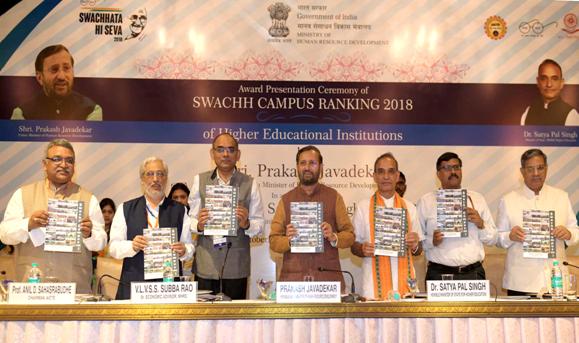
Government has approved setting up of 9 Research Parks one each at IIT Madras, IIT Kharagpur, IIT Bombay, IIT Gandhinagar, IIT Delhi, IIT Guwahati, IIT Kanpur, IIT Hyderabad, and IISc Bangalore. IIT Madras Research Park, which is fully functional with 43 R&D clients, 4 Incubators, 55 Startups, and 5 Centres of Excellence was established at a total cost of Rs. 447.66 crore, which includes grants-in-aid of Rs.137 crore from the Government. The Research parks at IIT Kharagpur and IIT Bombay are under construction at a cost of Rs.100 crore each, out of which a sum of Rs.100 crore has been released to IIT Kharagpur and Rs.33 crore to IIT Bombay.
IIT Gandhinagar Research Park currently under construction has been approved at a cost of Rs.90 crore with full funding from the Department of Science & Technology, which has released a sum of Rs.40 crore as on date.
Remaining Five new Research Parks at IIT Delhi, IIT Guwahati, IIT Kanpur, IIT Hyderabad, and IISc Bangalore at a total cost of Rs.75.00 crore each have been approved by the Government.
§ IMPRINT initiative was launched by the President, Prime Minister and the Human Resource Development Minister in November, 2015 to channelize the research in premier institutions into areas that can have largest social and economic good for the country.
§ Under this initiative, research projects under 10 selected domains are jointly funded by MHRD and other participating Ministries/Departments. These domains are: health care, energy, sustainable habitat, nano technology hardware, water resources and river systems, advanced materials, information and communication technology, manufacturing, security and defence, and environmental science and climate change.
§ 142 research projects with an outlay of Rs. 323.16 crore for 3 years with joint funding from MHRD and participating Ministries in the ratio of 50:50 have been approved and currently under execution under IMPRINT-I.
§ IMPRINT-II has now been launched as a corpus jointly set up by M/o HRD and Deptt. Science & Technology as well as contribution from various other ministries. The scheme is opened to all CFTIs and CUs as principal investigator (PIs) while other institutions including private institutions can participate as joint PI. The average cost of each proposal will be about Rs. 2 crore with a duration of 3 years. An outlay of Rs. 335 cr each from MHRD and DST share has been approved. Thus, the dedicated corpus is Rs. 670 cr for Imprint II.
§ Under IMPRINT-II, 122 projects totaling Rs. 112 cr has been approved. Further, under IMPRINT-II, specific challenges are being called from different ministries. Solution of these will be funded by IMPRINT-II.
UCHCHTAR AAVISHKAR ABHIYAAN
§ The scheme was launched to promote industry-specific need-based research so as to keep up the competitiveness of the Indian industry in the global market. All the IITs have been encouraged to work with the industry to identify areas where innovation is required and come up with solutions that could be brought up to the commercialization level.
§ Under the UAY, it is proposed to invest Rs. 250 crores every year on identified projects proposed by IITs, provided the Industry contributes 25% of the project cost. For the year 2016-17, (92) projects for Rs. 285.15 crore have been approved for implementation.
§ IIT Madras is the National Coordinator of the scheme. (160) proposals have been received of which industry has agreed to contribute Rs. 156 Cr, making this one of the biggest ever industry-academia partnership. These research projects are expected to result in registration of patents.
§ Global Initiative for Academics Network (GIAN): Global Initiative of Academic Networks (GIAN) in Higher Education was launched on 30th November, 2015. The programme seeks to invite distinguished academicians, entrepreneurs, scientists, experts from premier institutions from across the world, to teach in the higher educational institutions in India
No. of Courses approved till date: 1417
Courses already organized: 1037
No of host Institutions: 138
§ UGC (Institutions of Eminence Deemed to be Universities) Regulations, 2017 have been notified to create a distinct category of Deemed to be Universities, called Institutions of Eminence Deemed to be Universities, which would be regulated differently from other Deemed to be Universities so as to evolve into Institutions of world class in reasonable time period. Also, in order to assist Indian Higher Education Institutions to get a rank within the top 100 in globally renowned rankings, accordingly The Government has shortlisted Six Institutions of Eminence (IoEs) including 3 from Public Sector and 3 from Private Sector. An Empowered Expert Committee (EEC) in its report recommended selection of 6 institutions (3 from public sector and 3 from private sector) as Institutions of Eminence. The details of these Institutions are as under:
§ Public Sector: (i) Indian Institute of Science, Bangalore, Karnataka; (ii) Indian Institute of Technology, Bombay, Maharashtra; and (iii) Indian Institute of Technology, Delhi.
§ Private Sector: (i) Jio Institute (Reliance Foundation), Pune under Green Field Category; (ii) Birla Institute of Technology & Sciences, Pilani, Rajasthan; and (iii) Manipal Academy of Higher Education, Manipal, Karnataka.
§ Government Institutions will get financial assistance of 1000 crores over a period of five years in addition to the grant already being received. The institutions selected from the private sector will have complete autonomy to promote innovation and creativity expected to result in producing competent graduates for the development of the country.